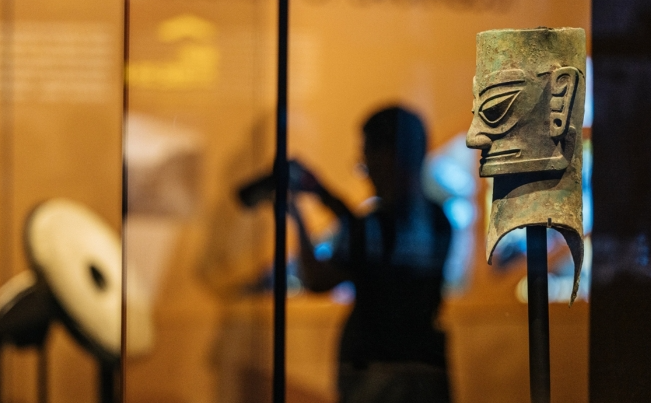The Grand Canal Museum of Beijing saw a surge of visitors on Thursday as the “Unveiling Sanxingdui of Ancient Shu Civilization” exhibition opened its doors. This exhibition, which features 265 artifacts, has drawn pieces from 12 cultural institutions and museums, with many of the relics leaving Southwest China’s Sichuan Province for the first time.
Among the 265 exhibits, 46 sets are classified as national first-class cultural relics. The collection includes bronze vessels, jadewares, goldwares, and pottery. Highlights such as the Bronze Standing Figure, Bronze Sun-shaped Object, and the Bronze Twisted Kneeling Figure have particularly captivated visitors. These artifacts, alongside a group of gold foil dating back to the Shang Dynasty (c.1600BC-1046BC), provide a glimpse into the enigmatic Sanxingdui culture.
Sanxingdui artifacts continue to mystify scholars. Gao Hongqing, a research fellow at Beijing’s Capital Museum, explained that the Bronze Sun-shaped Object, one of two items restored by archaeologists, suggests that ancient people worshiped the sun. “Some people think it looks like a carriage wheel or a shield,” Gao said. “There is room for imagination, and further evidence is needed to confirm these theories.”
Another standout piece is the massive bronze mask, the largest discovered at the Sanxingdui ruins. Gao noted that scholars are still debating its use. “The holes in the mask suggest it might have been hung on a tree or mounted on wood during sacrificial ceremonies,” he said.
Yu Jian, vice curator of the Sanxingdui Museum in Guanghan, Southwest China’s Sichuan Province, introduced a bronze mask with protruding eyes and a headdress, adding to the intrigue of the collection.
The unique shape of the Bronze Standing Figure with Towering Strands of Hair and the intricate details of the Bronze Twisted Kneeling Figure also impressed visitors. The latter, unearthed from the No.4 sacrificial pit in Sanxingdui in 2021, features decorations of cloud, thunder, swallowtail, and feather crown patterns—motifs never before seen in Sanxingdui artifacts.
“In 2024, the Year of the Dragon, we are also showcasing items with dragon elements, such as a bronze dragon with a tiger head, a bronze scepter with a climbing-dragon-shaped finial, and a newly restored bronze cone-shaped finial cap with cloud patterns,” said Gao.
The exhibition aims to raise awareness about the Sanxingdui and Jinsha sites, both significant archaeological discoveries of the ancient Shu civilization in Sichuan Province. Both sites are currently applying for UNESCO World Cultural Heritage status. Visitors can learn about the criteria for UNESCO World Cultural Heritage Sites at the exhibition’s conclusion. The Jinsha site was included on the preliminary list for world cultural heritage declaration in 2006, along with the Sanxingdui ruins.
In addition to the exhibition, the Grand Canal Museum of Beijing is hosting a VR immersive experience, allowing visitors to explore the Sanxingdui ruins and participate in an interactive Q&A with representations of ancient Shu people.

